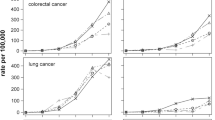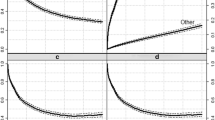Abstract
Emigration causes loss to follow-up. The study aim was to assess the influence of the choice of handling migration in population-based cohort studies on estimated mortality and cancer incidence in the population of origin. All persons born in Norway between 1967 and 1976 and who were not registered dead before 1992 (N = 614,176) were followed up in national registries regarding migration movements, death, and incident cancer between 1992 and 2004. A total of 40,366 (6.6%) of the study population had between 1 and 13 migration movements and 5,354 deaths and 4,447 first cancer cases were recorded during follow-up. Four different follow-up scenarios concerning migration were analysed: considering only person-time before emigration; considering person-time as national residents both before emigration and after repatriation; disregarding whether emigration took place or not; and excluding all who emigrated during follow-up. Mortality and cancer incidence rates were compared in Poisson regression models. Mortality and cancer incidence were only marginally influenced by choice of follow-up scenario. Mortality was higher after repatriation, in particular during the first year of follow-up (rate ratio 2.03; 95% confidence interval 1.02–4.03). This excess had little influence on total population rates. Cancer incidence was not affected by repatriation status. Mortality rates after repatriation were probably elevated because persons who expected to die shortly were more prone to return to their native country (“salmon bias”). The analytical choice concerning follow-up has little influence on outcome occurrences in populations with rather low migration rates. However, the best solution is apparently to censor out persons at the date of emigration in order to avoid salmon bias.

Similar content being viewed by others
References
Mittendorfer-Rutz E, Wasserman D, Rasmussen F. Fetal and childhood growth and the risk of violent and non-violent suicide attempts: a cohort study of 318 953 men. J Epidemiol Community Health. 2008;62:168–73.
MacMahon B, Pugh TF. Epidemiology: principles and methods. Boston: Little Brown and Company; 1970. p. 229–32.
Wadsworth MEJ, Mann SL, Rodgers B, Kuh DJL, Hilder WS, Yusuf EJ. Loss and representativeness in a 43 year follow up of a national birth cohort. J Epidemiol Community Health. 1992;46:300–4.
Wadsworth MEJ, Butterworth SL, Hardy RJ, Kuh DJ, Richards M, Langenberg C, et al. The life course prospective design: an example of benefits and problems associated with study longevity. Soc Sci Med. 2003;57:2193–205.
Atherton K, Fuller E, Shepherd P, Strachan DP, Power C. Loss and representativeness in a biomedical survey at age 45 years: 1958 British birth cohort. J Epidemiol Community Health. 2008;62:216–23.
Saurel-Cubizolles M-J, Chastang J-F, Menvielle G, Leclerc A, Luce D for the EDISC group. Social inequalities in mortality by cause among men and women in France. J Epidemiol Community Health. 2009;63:197–202.
Helgesen F, Holmberg L, Johansson J-E, Bergström R, Adami H-O. Trends in prostate cancer survival in Sweden, 1960 through 1988: evidence of increasing diagnosis of nonlethal tumors. J Natl Cancer Inst. 1996;88:1216–21.
Williams R, Ecob R. Regional mortality and the Irish in Britain: findings from the ONS longitudinal study. Sociol Health Illn. 1999;21:344–67.
Davey Smith G, Chaturvedi N, Harding S, Nazroo J, Williams R. Ethnic inequalities in health: a review of UK epidemiological evidence. Crit Public Health. 2000;10:375–408.
Abraído-Lanza A, Dohrenwend BP, Ng-Mak DS, Turner JB. The Latino mortality paradox: a test of the “salmon bias” and healthy migrant hypotheses. Am J Public Health. 1999;89:1543–8.
Gushulak BD, MacPherson DW. The basic principles of migration health: population mobility and gaps in disease prevalence. Emerg Themes Epidemiol. 2006;3:3. doi:10.1186/1742-7622-3-3.
Ringbäck Weitoft G, Gullberg A, Hjern A, Rosén M. Mortality statistics in immigrant research: method for adjusting underestimation of mortality. Int J Epidemiol. 1999;28:756–63.
Bjerkedal T. The medical birth registry of Norway. In: Mednick SA, Baert AE, editors. Prospective longitudinal research: an empirical basis for the primary prevention of psychosocial disorders. Copenhagen: Oxford University Press; 1981. p. 58–60.
Statistics Norway. Death statistics. http://www.ssb.no/english/subjects/02/02/10/dode_en/about.html. Accessed 2 Sep 2009.
The Cancer Registry of Norway. Cancer in Norway 2007. http://www.kreftregisteret.no/Global/Publikasjoner%20og%20rapporter/CiN2007_del1_web.pdf. Accessed 2 Sep 2009.
Akselsen S, Lien S, Siverstøl Ø. FD-trygd: list of variables. Report 2007/5. Oslo-Kongsvinger: Statistics Norway, 2007. http://www.ssb.no/english/subjects/03/04/doc_200705_en/doc_200705_en.pdf. Accessed 2 Sep 2009.
Statistics Norway. Norwegian standard classification of education (Revised 2000). Oslo-Kongsvinger: Statistics Norway, 2003. http://www.ssb.no/english/subjects/04/90/nos_c751_en/nos_c751_en.pdf. Accessed 2 Sep 2009.
Acknowledgments
We thank Ola Thune at the Norwegian Labour and Welfare Administration and Geir Skjeret at Norwegian Armed Forces Medical Services for preparing the files that led to this work. The project is funded by the National Institute of Occupational Health and the Norwegian Armed Forces Medical Services.
Ethics approval
The Regional Committee for Medical Research Ethics approved the study (Ref. no. S-06028).
Author information
Authors and Affiliations
Corresponding author
Rights and permissions
About this article
Cite this article
Kristensen, P., Bjerkedal, T. Dealing with emigration in cohort studies: follow-up of mortality and cancer incidence among Norwegians born between 1967 and 1976. Eur J Epidemiol 25, 155–161 (2010). https://doi.org/10.1007/s10654-009-9417-9
Received:
Accepted:
Published:
Issue Date:
DOI: https://doi.org/10.1007/s10654-009-9417-9




